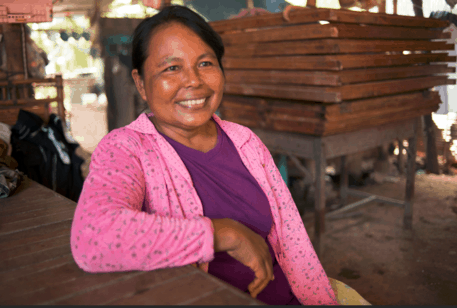How Impact Investing is Advancing Affordable Housing
Habitat for Humanity’s name is synonymous with affordable housing. Since 1976, Habitat has provided housing solutions to families across the globe through a combination of a family’s sweat equity and volunteer mobilization. While Habitat has helped over 13.2 million people meet their affordable housing needs, approximately 1.6 billion people live in substandard housing — a worldwide need beyond the reach of government and philanthropy alone. In response, Habitat’s strategy has evolved to include a focus on facilitating more inclusive, efficient housing market systems. To that end, Habitat established the Terwilliger Center for Innovation in Shelter to work with local firms in expanding innovative and client-responsive services, products and financing, so that low-income households can improve their shelter more effectively and efficiently.
For low-income families in the developing world, improving a home means relying on financing options, construction services and materials available in their local market, but these products and services can be expensive, of poor quality, or simply ill-suited to serve their needs. Mortgages remain a privilege for only the few — an average of just 3 percent of the global population has an outstanding mortgage. For the rest of the population, housing is a process of incremental upgrades and additions, which can be costly and quite slow. At the Terwilliger Center, we’re addressing constraints on both the supply and demand side of the housing market system through two innovative impact investment funds: the MicroBuild Fund and the Shelter Venture Fund. We believe these two funds can offer lessons to other organizations on the social impact and financial viability of investing in affordable housing markets.
MicroBuild Fund
Due to the failure of the formal finance market, many low-income families turn to microfinance institutions as an alternative to other informal mechanisms for savings and credit. Globally, microfinance institutions serve an estimated 200 million low-income clients representing a combined current lending portfolio of US$70 billion. However, at present, MFIs allocate less than 2 percent of their funds to housing. While microfinance institutions have provided access to financial services for the unbanked for decades, loans have been limited mainly to microenterprise or income-generating purposes. Yet practitioners estimate that between 10-20 percent of the loans borrowed for microenterprises are diverted for housing purposes.
Indeed, the shorter-term, unsecured financial products characteristic of traditional microfinance seem well-poised as a solution to this market constraint, yet few microfinance institutions were offering dedicated housing products. Our research revealed three main barriers to scaling housing finance: availability of long-term capital, lack of technical know-how to develop a dedicated housing product and lack of tenure security.

Sreymom (pictured) received a housing loan from LOLC, a microfinance institution in Cambodia, made possible by the MicroBuild Fund. (Image courtesy of LOLC).
In 2012, Habitat launched the MicroBuild Fund, a 10-year, US$100 million fund that is the first housing-specific microfinance investment vehicle. Advisory services are provided to microfinance institutions to help develop and/or refine their housing products, build the capacity of loan officers to underwrite such products, and scale the offerings to reach more clients. MicroBuild’s capital is then on-lent to microfinance institutions to package as incremental housing loans for low-income families. By providing long-term capital and advisory services, MicroBuild addresses the lack of housing finance options available to low-income households. It serves to demonstrate the financial viability and the opportunity to scale up these products to meet the vast housing demand, as well as to demonstrate the potential positive returns this sector holds for investors.
As of its fifth anniversary in June 2017, MicroBuild had disbursed US$74.3 million in financing to 42 institutions, across 25 countries. This financing has served 83,000 housing microfinance clients and impacted the lives of 415,000 individuals. In addition, MicroBuild investees have been able to leverage this investment to increase their housing microfinance portfolios by an additional US$202.9 million since inception, a leverage multiplier of nearly threefold. Housing microfinance portfolios now represent 14.3 percent, on average, of investees’ overall lending portfolios, and the performance of the housing portfolios continues to surpass that of overall lending portfolios.
Shelter Venture Fund
Though our initial interventions focused on the financial inclusion sector, Habitat recognizes that housing finance is not the only intervention required to improve affordable housing markets. For example, low-income households may lack access to environmentally sustainable options for housing components, and local masons may lack training in newer techniques. Local norms may dictate building material selection at the expense of durability and affordability.
To address these supply side constraints, the Terwilliger Center for Innovation in Shelter is working with shelter-focused providers of innovative products and services to adapt their offerings to better target low-income households. Through the recently formed Shelter Venture Fund, the Terwilliger Center is mobilizing funds to early-stage innovators of housing-related products and services. The goal is to enable them to scale up their operations to meet the demands of low-income households.
Since the fund’s launch in July 2017, US$1.45 million in approved investments have been made, which will support five firms across four countries. The investees include: BURN (Kenya), Energryn (Mexico), VitaLuz (Mexico), ReMaterials (India) and EarthEnable (East Africa). Habitat, through the Terwilliger Center, is committed to furthering efforts to spur markets that are inclusive of low-income households and result in increased efficiency and resiliency in incremental building. We encourage investors to consider both the vast potential for impacting the 1.6 billion in need of adequate shelter, and the opportunity for diversification and profitability these investments present.
To review our latest research and findings, including the results of recent surveys of investors in affordable housing and of housing microfinance practitioners, visit our website. If you would like more information on the investment opportunity, please send an email to tcis@habitat.org.
Jyoti Patel is global director-capital markets at Habitat’s Terwilliger Center for Innovation in Shelter.
Top photo: A roof made with a solution from ReMaterials stands in contrast with typical roofs in an Indian slum. ReMaterials is an investee company of the Shelter Venture Fund. Image courtesy of Terwilliger Center for Innovation in Shelter.
- Categories
- Investing



